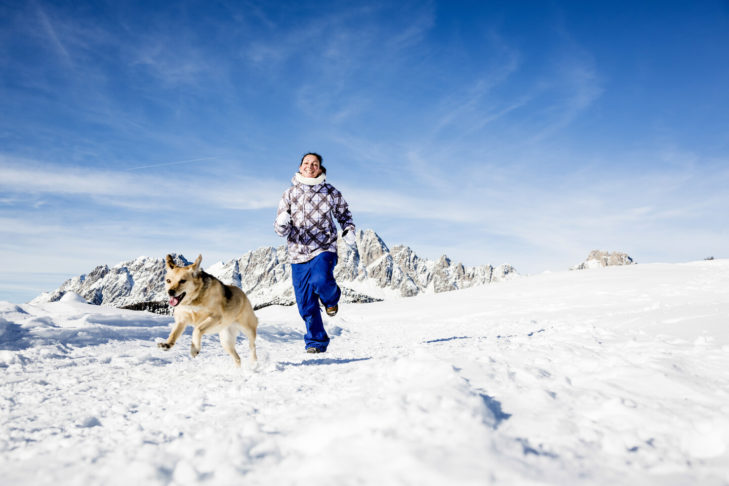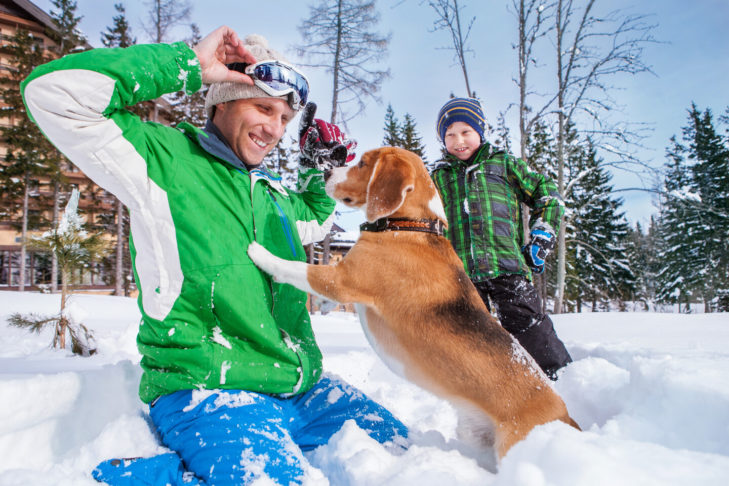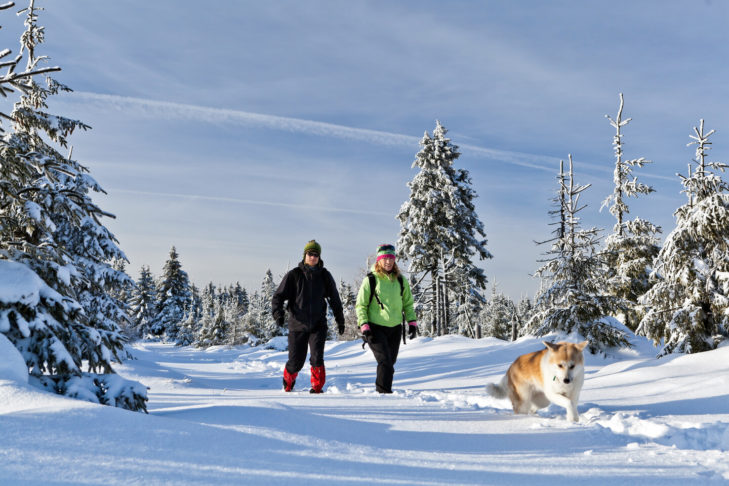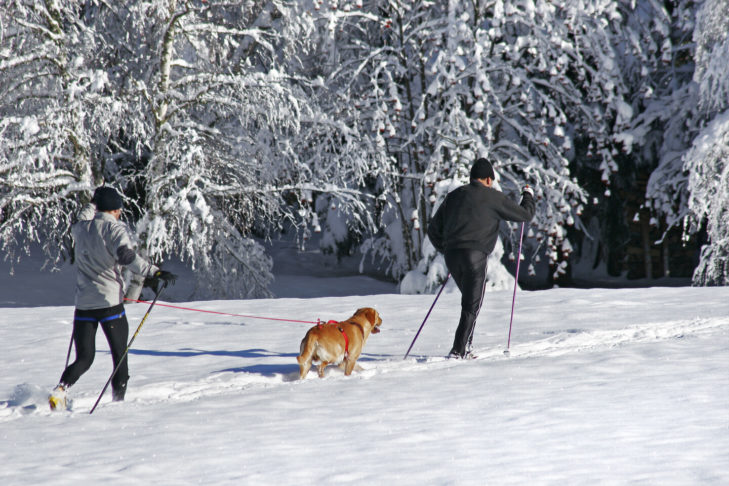Is skiing with a dog even possible? This is a question that many winter sports enthusiasts ask themselves, but SnowTrex says: Yes, it’s possible! There are a few things to consider when skiing with a dog, but if everything is well-prepared, an exceptional holiday experience awaits man and dog. This is what winter travellers should bear in mind on their holiday in the snow with a dog:
There are numerous things to consider when skiing with a dog – every dog owner knows that. But winter presents special challenges for owner and animal: snow and cold, limited exercise, long hours without master or mistress and people everywhere with those funny boards on their feet. It is important to prepare the dog well for these conditions.
Properly equipped for the trip
If the skiing holiday with dog goes abroad, the owner must show some significant “documents” when entering the holiday country. Dogs generally need an animal identification to clearly identify them or to assign them to their owner. This identification usually takes the form of a tag on the collar or an electronic transponder chip implanted under the skin. For travel abroad, this identification is just as obligatory as the EU pet passport, in which, for example, rabies vaccinations are entered. The vet issues the blue passport for a few euros.
When travelling to Austria or France, for example, a leash and muzzle must also be included in your luggage. If you are travelling by car, the animal must be adequately secured, for example with a dog belt or in a transport box. On the journey, there should always be enough fresh water available and several breaks with opportunities to run around.
Choosing the right accommodation
If you want to take your furry friend to a hotel or guest house for skiing with your dog, you should find out exactly what the local conditions are beforehand. Many hotels allow pets, but in some places the dog’s stay costs extra and food is usually not included in the price. So make sure you pack enough dog food for the entire stay because even the local supermarket may not stock all types of food. Accommodation should therefore be chosen carefully.
Tip: SnowTrex offers the filter “Pets” in the detailed search, which immediately displays all available accommodation where dogs and co. are welcome.
In addition, it is advisable to ask the host in advance whether the dog is allowed to stay alone in the room or flat. If you ask, you might be lucky that the landlord will even look after the animal. However, this is a rare exception. If this is not possible, alternative care must be found.
Dog sitter in the resort
Since dogs are not allowed on ski slopes, it is difficult to combine skiing with a dog. If your mistress and master want to go skiing, this means that the dog has to stay alone or with strangers for several hours, but it is usually not allowed to stay alone in the accommodation. The best alternative is a privately hired dog sitter, possibly arranged by the hotel or found on the internet. On the other hand, there are practically no proper dog day-care centres in the ski resorts. If you want to combine a skiing and dog holiday, it is best to travel with your partner or friends so that you can take turns looking after your pet. Or you can opt for other snow sports that you can experience together with your dog.
Out and about
Fortunately, as an alternative to the slopes, there are various other winter sports activities where dogs can join you on holiday in the mountains. Walking, hiking, tobogganing, horse riding, cross-country skiing – there are many possibilities. Going for long walks or snowshoe hikes through snow-covered landscapes while Bello romps around in the snow and chases snowballs – this is relaxing for dog and owner. But there are also a few things to keep in mind on walks and hiking tours: The path should not be too steep or rough. Not every breed can run effortlessly for hours through deep snow. Also pay attention to trail markings and possible wildlife signs. When walking in wooded areas, all dogs should generally be kept on a lead as they may spook game or be tempted to chase.
When walking in the snow, it can happen that lumps of snow and ice get stuck between the pads of the dog’s paws, which can disturb the dog when walking or even cause him pain. It is best to check occasionally whether the paws are still free of ice. To protect the pads from injuries caused by cold, ice or road salt, it is also advisable to apply Vaseline or milking grease. For already cracked or very sensitive pads, there are dog shoes so that the next walk in the snow will still be fun. In addition, you can trim the shag on the belly of dogs with long fur to avoid too much accumulation of dirt and ice. Tip: Have a dog towel ready to rub the wet animal dry when you return home.
Dog gondolas
A great experience on a holiday in the mountains with a dog is an excursion on high-altitude paths and to mountain peaks, some of which can only be reached by cable car. In some ski resorts, four-legged friends are also allowed in the gondola – but only with a leash and muzzle. For example, dogs and their masters can reach the Zugspitze near Garmisch-Partenkirchen, the Nebelhorn in Oberstdorf or the Krippenstein in the Salzkammergut Dachstein and thus beautiful vantage points that serve as the ideal backdrop for a pretty souvenir photo.
Cross-country skiing with a dog
Since dogs are not welcome on cross-country skiing trails and are even forbidden in many places, dog trails have been established especially for dog owners in Switzerland and Austria. Here, the four-legged friends are allowed to run alongside the track. The service of the dog trails also includes dispenser boxes with dog excrement bags so that the owner can quickly and cleanly remove the dog excrement.
To be on the safe side and avoid trouble with other Nordic sports enthusiasts, dog owners should ideally only use designated dog trails with their pet.
Cross-country skiing tips
In Pertisau on Lake Achensee, for example, a beautiful 1-km circuit has been laid out for dog lovers, and in Leutasch in Styria there is one over 1.5 km long. The 1.9 km long dog cross-country trail over the Lenerwieser in the Olympiaregion Seefeld is exceptional, as it is even suitable for skaters. In Saalfelden in the Pinzgau Saalach Valley, dog and master can let off steam over a whole 10-km stretch. Switzerland also has many dog trails. A good two dozen special trails run mainly through the holiday region of Graubünden and the Bernese Oberland. The longest trail near Davos measures 15 km. Whether it is possible to take your dog along on normal cross-country trails that are considered “dog-friendly” must be checked on site in each individual case. Whether you can take your dog on the trail ultimately depends on its temperament and how well it obeys.
One thing is certain: For dog owners who do not want to leave their animal companion alone, cross-country skiing is a great alternative to alpine skiing.
Conclusion
Even if there is still room for improvement in the care facilities for dogs in the ski resorts, it is definitely worth taking your best friend on four paws with you on your winter holiday. Click here for a selection of our accommodation for skiing holidays with dogs.






